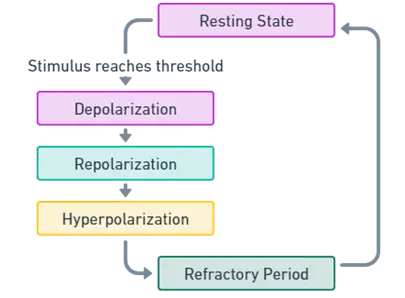- An action potential, also known as a nerve impulse, is a rapid and temporary change in the electrical potential across the cell membrane of a neuron.
- It serves as the primary means of transmitting information within the nervous system.
- Action potentials are all-or-nothing events, meaning they either occur with full amplitude or not at all, and they propagate without decrement along the axon.
Here is a detailed explanation of the different phases of an action potential in the context of the nervous system:
Resting state:
- Neuron is not actively transmitting signals; resting membrane potential is around -70 mV.
This is a sample ad placement!
Stimulus and depolarization:
- External stimulus cause local depolarization. If threshold (-55 mV) is reached, voltage-gated Na+ channels open, causing further depolarization and membrane potential to rise.
Repolarization:
- Voltage-gated Na+ channels close, and voltage-gated K+ channels open, allowing K+ ions to exit the cell, causing the membrane potential to decrease (repolarize) back towards resting state.
This is a sample ad placement!
Hyperpolarization and after-hyperpolarization:
- K+ channels may remain open slightly longer, causing an overshoot of the membrane potential, leading to temporary hyperpolarization before returning to resting level.
Refractory period:
- Neuron enters a period where it is difficult or impossible to generate another action potential; divided into absolute and relative refractory periods to ensure unidirectional propagation of action potentials along the axon.
This is a sample ad placement!

Thank you for reading from Firsthope's notes, don't forget to check YouTube videos!

